Authors:
- Shiv Kumar - Senior Scientist, National Centre for Agricultural Economics and Policy Research (NCAP), DPS Marg, Pusa, New Delhi
- Kanika - Senior Scientist, NRC Plant Biotechnology, LBS Building, IARI, Pusa Campus, New Delhi
The world population touched an important milestone of seven billion living persons in 2011. To feed the population growing at this pace, the need for increasing production of food and non food commodities remains important. Economists believe that ingenuity could be embedded into technology in overcoming the challenges of food deficits. Biologists have empirically shown that technology can be embedded in seed. After Green Revolution, introduction of transgenic hybrid cotton in India is the landmark in the annals of agricultural research and developmental strides the country has treated (Ramasundaram et.al. 2012). Poverty and hunger are inseparably linked. Nearly half of the world’s poor are small resource-poor farmers, whilst another one fifth are the rural landless whose livelihoods are completely dependent on agriculture. Transgenic technology can contribute to food and feed security and self sufficiency by increasing crop productivity. This will also ensure sustainable economic benefits to the farmer as a result of reduced cost of production due to less ploughing and labour and fewer pesticide sprays required for transgenics. Transgenics can be used to reduce the environmental footprint of agriculture. Transgenics with improved tolerance to drought will prove beneficial in giving good yield even under water limiting conditions. Adoption of transgenic cotton has made significant contribution to the income of million small resource-poor farmers in developing countries such as China, India, Pakistan, Myanmar, Bolivia, Burkina Faso and South Africa (Gao and Feng, 2010; Laibuni et al, 2012).
Agriculture and human well-being will be negatively affected by climate change, particularly in the developing countries as has been highlighted by IFPRI study. Droughts, floods and temperature changes are predicted to become more prevalent and more severe as we face the new challenges associated with climate change. So there is a need for dedicated crop improvement programs to develop varieties and hybrids that are well adapted to rapid changes in climatic conditions. IFPRI estimated that almost forty percent of the world population rely on agriculture for their livelihood and are likely be the most severely affected (IFPRI, 2009). Indeed, the effect of climate change on world agriculture will depend not only on altered climate conditions, but on ability and resilience of the agricultural sector and the speed with which it can adapt and develop new and improved crops to deal with opportunities and threats posed by changed climatic conditions. In brief, transgenic crops are capable of increasing productivity and income and can serve as an engine of rural economic growth. Hence it is indispensable to get insights of the extent of commercialization of transgenic crops and to estimate the pace of penetration of technology in the landscape of Indian cotton scenario.
Commercialization of transgenic crops
China was the first country to commercialize transgenic crops in the early 1990s. The first approval for commercial sale of a genetically modified product for food use was in the United States in 1994 when Calgene marketed its delayed ripening tomato Flavr-Savr. Since then, the number of countries growing transgenic crops has increased from one to twenty nine. Global acreage of transgenic crops increased from 1.7 million ha in 1996 to 160 million hectare in 2011 (James, 2011). A 94-fold increase in acreage makes transgenic crops the fastest adopted crop technology in the history of modern agriculture. Farmers across the world elected/decided to adopt transgenics due to the benefits they offer. The only reason that explains the trust and confidence of risk-averse farmers in transgenics is because they deliver substantial, sustainable and socio-economical benefits.
Biotech cotton was first transgenic plant to be commercialized. Insect resistant cotton, featuring Bt genes, and herbicide tolerant cotton were amongst the first products to be commercialized. Their impact has been substantial in all the countries where they have been commercialized, growing from less than one million hectares globally in 1996 to ~25 million hectares in 2011 (James, 2011). Insect resistant Bt cotton has been grown on a larger area, compared with the stacked product and herbicide tolerant cotton. Bt cotton has been the major contributor to adoption and growth of transgenics, however, it is the stacked traits of insect resistance (Bt) and herbicide tolerance traits that are coming up now. Bt cotton has changed the pattern of cotton production in India. We completed a decade of successful cultivation of Bt cotton in 2011. Phenomenal success has been achieved in transforming the cotton crop into the most productive and profitable crop in the country. India’s Bt cottons are unique in that they are hybrids and not varieties, as used by all other countries. Bt cotton in India surpassed the historical milestone of ten million hectares. The principal beneficiaries were seven million farmers growing, on an average, 1.5 hectares of cotton. There has been nearly 200 fold increase in acreage of Bt cotton in last ten years (Guillame and Sun, 2012). Thus, Bt cotton has transformed cotton production in India by increasing yield substantially, decreasing insecticide applications by half. According to Brookes and Barfood (2012) the cost of cotton production has reduced around US$ 23/ha in 2010-11 from US $ -12/ha in 2002-03.The net increase in gross margins in 2010-11 has reached US $266/ha from US $ 82.7/ha in 2002-03. Similarly, there is progress in increase in farm income from US $ 3.7 million in 2002-03 to US $ 2499 million in 2010-11. This has led to alleviation of poverty of a number of small resource-poor farmers. This technology has shown power to cut cost of production and has increased farm income substantially which results in significant net increase in gross margins.
Area, Production and Yield of Cotton in India
Figure 1 shows that India has achieved significant progress in cotton cultivation on all the three fronts - area, production and yield. The average yield of cotton in India, which used to have one of the lowest yields in the world, increased from 308 kg per hectare in 2001-02, to 521 kg per hectare in 2006-07 with 50% or more of the increase in yield, attributed to Bt cotton. This sustained high cotton yield of around 500 kg per hectare was achieved despite significant increases in area under cotton. Thus, at a national level, Bt cotton is a major factor contributing to higher cotton production which increased from 15.8 million bales in 2001-02, to 28 million bales in 2005-06, to 34.51 million bales in 2011-12, which was a record cotton crop for India (Cotton Advisory Board, 2012).
Figure 1: All India Area , Production and Yield of cotton (1950-51 to 2010-11)
A comparison of the all India compound growth rates data of the Department of Economics and Statistics, Ministry of Agriculture - for area, production and yield of cotton during 1991-2000 with those for the period 2001-2010 (Figure 2) is indicative of the fact that during past decade, the improvement in production and productivity seems to be the result of dissemination and adoption of improved technologies as there was practically very little increase in the cotton area.
Figure 2: All India compound growth rates for area, production and yield of cotton
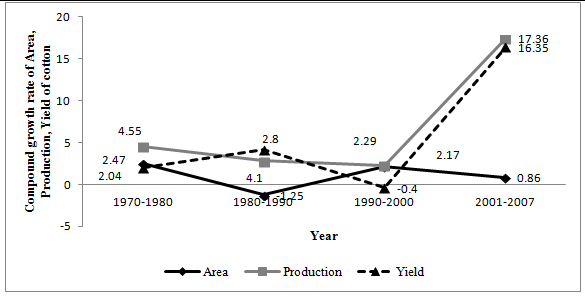
One of the main objectives of agricultural policies and technologies in low-income countries is to improve the well-being of the poor households which is possible only when there is stable agricultural incomes through new crop varieties that enhance productivity and reduce yield variability under different conditions. While past research has focused almost exclusively on benefits generated by expected mean yield increases, the present study also estimates the benefits of yield variance reductions as measured by risk reduction to producers and consumers. Such variance reductions are often the main goal of agricultural research. In case of cotton, a state wise analysis of data shows that apart from Madhya Pradesh and Tamil Nadu yield growth is accelerating. Figure 3 also shows a consistently falling trend in yield variability across all the states which is an encouraging outcome.
Figure 3: Variability in cotton yield in different cotton growing states of India
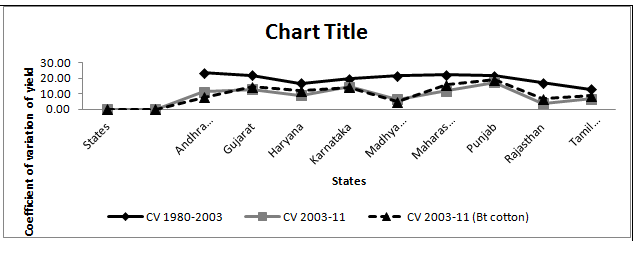
Adoption of Bt cotton in India
The Government of India through Genetic Engineering Approval Committee (GEAC), Ministry of Environment and Forests considered the proposal for the commercial release of Bt cotton in its meeting held on 26th March, 2002 and after careful and in-depth consideration, accorded approval for release. Initially it was approved only for the Central (Gujarat, Maharashtra & Madhya Pradesh) and South zone states (Tamil Nadu, Andhra Pradesh & Karnataka). GEAC has approved the commercial cultivation of Bt cotton in North Zone from the year 2005-06. The area occupied by Bt cotton hybrids in 2002-03, the first year of commercialization, was 50,000 hectares. It increased significantly every single year and reached 9.4 million hectares in 2010-11, an impressive 188-fold increase in eight years, occupying 86% of 11 million hectares under cotton cultivation in 2010-11 (Figure 4). Bt cotton area coverage is 91% in A.P., 64% in Tamil Nadu and 10% in Karnataka contributing 69% of the total Bt area by South Zone. Similarly in Central zone 71% in M.P. 81% in Maharashtra and 52% in Gujarat are under Bt hybrids and occupying 69% of total Bt area. North zone contributes 59% of total Bt area having highest in Punjab 85%, Haryana 53% and Rajasthan 10%.
Figure 4: Adoption of Bt cotton in India
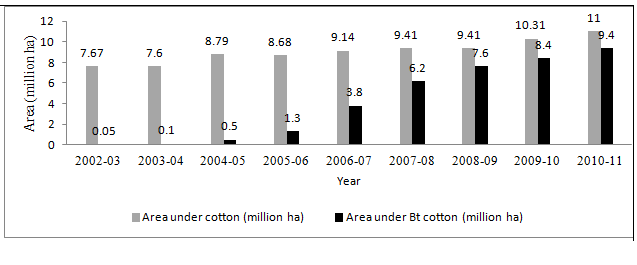
The Bt adoption was very less in Karnataka & Rajasthan i.e 10% only. Similarly, the number of farmers who planted Bt cotton also consistently increased from a few thousands in 2002 to a record of 6. 3 million farmers - a significant percentage of whom are small and resource-poor farmers. The figure below (Figure 5) shows the percentage of cotton farmers growing Bt and non Bt cotton in different states of India.
Figure 5: Percentage of farmers growing Bt cotton in different states of India in 2010-11.
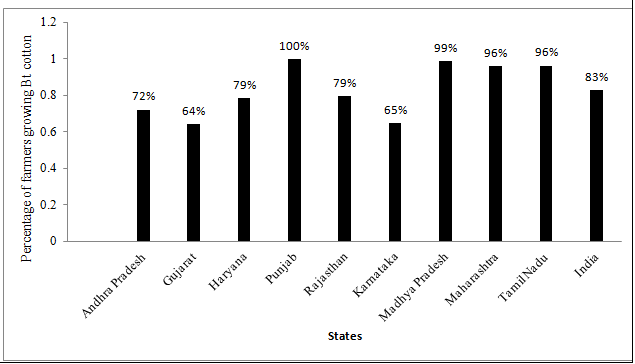
In recent years, there has been an increasing trend to adopt multiple gene (mostly two genes) Bt cotton hybrids by cotton farmers in India. Farmers prefer multiple genes over a single gene Bt cotton hybrids because multiple gene Bt cotton hybrids provide additional protection to Spodopetra (a leaf eating tobacco caterpillar) while it also increases efficacy of protection to both American bollworm, Pink bollworm and Spotted bollworm. It is reported that multiple gene Bt cotton farmers earn higher profit through cost savings associated with fewer sprays for Spodopetra control as well as increasing yield by 8-10% over single gene Bt cotton hybrids. In the first year 2006-07, the multiple gene Bt cotton hybrids were planted on 0.15 million hectares whilst single gene Bt cotton hybrids occupied 3.65 million hectares equivalent to 96% of all the Bt cotton planted. The situation is now reversed and the multiple gene Bt cotton hybrids have occupied the bulk of the Bt cotton area since 2009-10 (Figure 6).
Figure 6: Adoption of Single and Multiple Gene Bt Cotton Hybrids in India, 2006-2010 (Millions Ha)
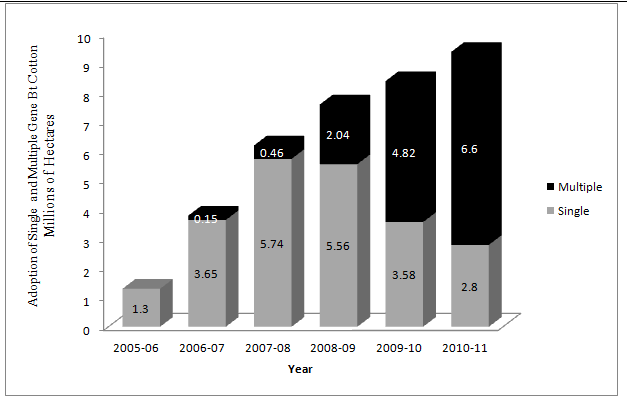
Approval of Events and Bt Cotton Hybrids in India
By 2009, 34 private sector seed companies were engaged in the production of Bt cotton, involving 522 Bt cotton hybrids (including one variety). The number of events, as well as the number of Bt cotton hybrids and companies marketing approved hybrids have all increased significantly from 2002, the first year of commercialization of Bt cotton in India. As seen in Figure 7, by 2010, the number of Bt cotton hybrids has increased substantially to 780 introductions (779 hybrids and one variety).
Figure 7: Number of Bt cotton hybrids
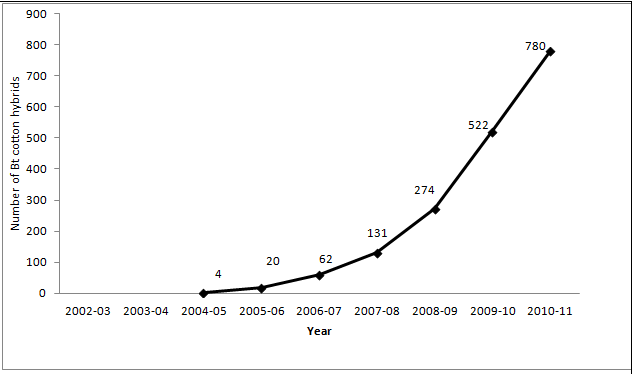
Importantly, this increase in number of hybrids has provided much more choice year after year to farmers where specific hybrids have been approved for cultivation in specific regions. By 2010, a total of six events were approved for incorporation in a total of 780 hybrids with a publically developed Bt cotton event Bikaneri Nerma (BNLA-601), approved in 2008 and the publicly-bred Bt cotton hybrid NHH-44 which was approved for commercial cultivation in 2009.
Transgenics Pathways:
In most of the countries especially India release of GM products into environment is subjected to strict regulatory regimes so that products are carefully assessed before approval is given. However, as now more and more products will be reaching the consumers, a review of objectives of public policy needs to be carried out. There are benefits to the environment by growing transgenic crops but there may also be risks. A comparative assessment of risks and benefits need be carried out. Most of the consumers or general public don’t understand how the transgenics are different from conventional crops. There is an urgent need to rebuild public confidence. Scientific community has to play an important role in disseminating information about safety of transgenics. The farmers should also have a say in policy making. We need to align our programmes of transgenic production to fulfil the needs of future. Future challenges of Indian agriculture could be addressed by producing transgenics which have improved, (a), resistance to sucking pests, pathogens like fusarium, verticillium, rhizoctonia, pythium, viruses, nematodes etc; (b), tolerance to various abiotic stresses like drought, salinity, high and low temperatures, water logging etc., (c), nutrient use efficiency and nutritional quality; and (d), yield /productivity as a result of increased efficiency of major metabolic pathways such as photosynthesis.
The Government of India supports a number of transgenic projects at its institutes, including brassica, tomato, cabbage, and cauliflower. So we have an opportunity to develop and release transgenic of crop of domestic importance involving both the public and private sectors. There is an urgent need for appropriate, science-based and cost/time-effective regulatory systems that are responsible, rigorous but not onerous, for India.
The adoption and success of transgenic crops in the future will mainly depend on (i), Production of improved biotech crops that will meet the challenges of producing enough food to meet the demand of growing population even under changed climatic conditions; (ii), Timely implementation of appropriate, responsible and cost/time-effective regulatory systems; (iii), strong political will-power; and (iv) financial and material support.
Transgenic technology has the potential to do good in the future. But this is possible if proper safety measures are taken. All of us who are involved in developing the new transgenics, need to recognise and accept a very important responsibility to public. We need to ensure that ethical concerns are taken into account and the products are safe for human consumption and are not harmful for the environment. We have to ensure that the true potentials of transgenic technology are harnessed to meet the most urgent food needs of the world as well as to reap commercial benefits. Bt cotton has shown the potential of technological change in production and transformed the landscape of Indian cotton scenario. This technological breakthrough has not only expanded the production frontier of cotton but also improved producer welfare. The concern is with emerging trend, the major firms have filed patents with excessively broad claims makes it difficult for developing countries to gain access to the new technologies. All of us including scientists, public and private sector along with charitable foundations and international research organizations need to join hands to ensure the safe application of transgenics to meet the demands of future.
References
Anonymous 2012. Directorate of Economics and Statistics (DES), Ministry of Agriculture and Cooperation, Government of India, various issues of publications (2002 to 2012).
Anonymous 2012. Cotton Advisory Board, Cotton Corporation of India Ltd, Ministry of Textile, Government of India, various issues of publications (2002-2012).
Brookes G. and P. Barfoot. 2012. GM Crops: Global Socio-economic and Environmental Impacts 1996-2010. P.G. Economics Ltd, Dorchester, UK. www.pgeconomics.co.uk/.../2010-global-gm-crop-impact-studyfinal-April-2010.pdf
Gao, Y.L, Feng, H.Q. and Wu, K.M. 2010. Regulation of the seasonal population patterns of Helicoverpa armigera moths by Bt cotton planting. Transgenic Research, 19(4): 557-562.
GoI (Government of India). 2011. Ground Water Year Book - India. Central Ground Water Board, Ministry of Water Resources, Faridabad.
Guillaume, P. Gruere and Yan Sun. 2012. Measuring the contribution of Bt cotton adoption to India’s cotton yields leap. IFPRI Discussion Paper 01170.
IFPRI. 2009. Climate Change Impact on Agriculture and cost of adaptation. Food Policy Report, International Food Policy Research Institute.
James, C. 2011. Global status of commercializated Biotech/GM crop-2011. International Services for Acquisition of Agri-Biotech Application.
Laibuni, N.M. Miriti, L.C., Waturn, C.N. Wessels, W and Ninju, S.M. 2012. Cost benefit analysis of transgenic cotton containing Cry1AC and Cry 2AB2 gene and Hart 89M- evidence from confined field trials in Kenya. African J. Hort. Sci., 6:27-34.
Ramasundaram, P., Kurup, Suresh A. and Chand, R. (2012). Maneuvering technological for surplus extraction: The case of Bt cotton in India. Policy Brief (37):1-5.
About Author / Additional Info:
Article published via email submission.